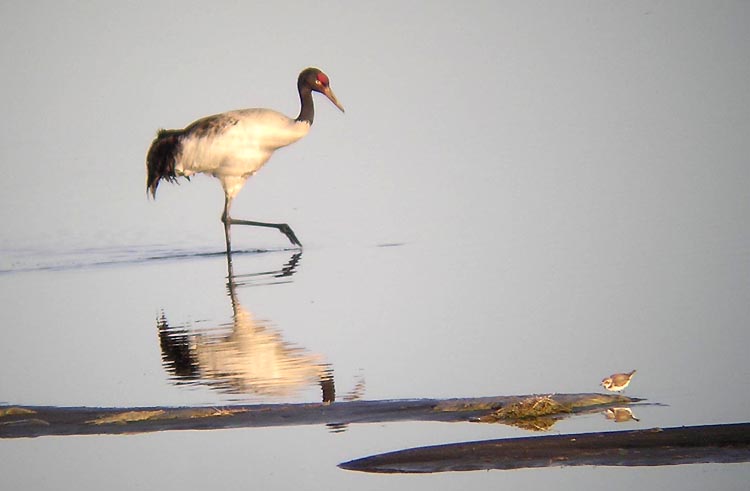| When Roger Wolfe loaned me Peter Matthiessen's The Bird of Heaven:
Travels with Cranes last December, a visit to China was well down the
list of places I hoped to visit around the world. After reading the book,
I began searching the web for bird tours to eastern Asia that might net
some of the scarcest and most remote species. Matthiessen's word pictures
on searching out all the cranes in the world were vivid and compelling,
and none more so than the northeast Asian species. There are five species
that breed here: Red-crowned Grus japonensis, Black-necked G.
nigricollis, Hooded G. monacha, White-naped G. vipio,
and Siberian G. leucogeranus. I settled on a Sunbird tour of north
China, led by Paul Holt, that promised reasonable shots at three of these
species (not to mention a good selection of other Manchurian and Tibetan
Plateau birds). Here is a quick look at the cranes we encountered. All
photos are digiscoped images. |
| Our first site for cranes was Xianghai National Nature Reserve in Jilin
Province, northeast China. This is the region often called Manchuria, although
this Japanese term is not used by the Chinese. We reached the reserve via
a 12-hour train trip from Beijing, and then a long drive. Distances in
China are vast and the reserve rather remote. The reserve has suffered
from a 6-7 year drought and many breeding marshes were now entirely dry.
Long, multi-hour drives over deep sand and bitterly rutted roads in 4-wheel
drive jeeps took us to the very remaining wet spots. At the first area
— a huge grassland — no cranes were initially present. But eventually a
pair of Red-crowned Cranes appeared in the distance, and one flew
closer for this view (below). Red-crowned Crane is often called
"Japanese Crane" because it is the species that breeds on Hokkaido, Japan,
and is famous from the dancing cranes often seen in film. Birdlife International
(2000) lists it as an Endangered species with three isolated populations:
Japan (~600 birds), Korea (~400 birds), and northeast China (~1200 birds).
Thus the world population is only ~2200 birds and declining. |
|

|
| The crane I most wanted to see, however, was White-naped Crane.
I think it may be the most elegantly beautiful of all the cranes. We found
only one pair — late in the morning after hours and hours of searching
at Xianghai — and views were fairly distant (right). This crane
prefers wetter habitats than the grasslands frequented by Red-crowned Crane,
and thus seemed to be even more affected by the drought .
The species breeds patchily from eastern Mongolia to southern Siberia,
and winters at specific sites in eastern China, in Korea (demilititarized
zone), and in Japan. The world population is 5500 to 6500 birds, and declining;
it is considered Vulnerable (Birdlife International 2000). |

|
|

|
The final species was Black-necked Crane. This species is almost
a China endemic. It breeds on high elevation lakes and wetlands on the
Qinghair-Tibetan Plateau, its range barely reaching to Ladakh, India, and
in winter to Bhutan. On our trip we encountered about 17 different birds,
including a half-dozen or so pairs (and saw an adult on a nest) in wetlands
adjacent to Qinghai Lake, a huge saltwater lake at 10,000' elevation. Birdlife
International (2000) lists this species as Vulnerable with an estimated
world population of 5600 to 6000 birds.
Paul Holt had told us in advance that all of our views of Black-necked
Cranes would be very distant.... and this was true for all but one pair
that we encountered on two different days. They foraged along the shoreline
of a freshwater lake (Xiao Bei Hu) adjacent to Qinghai Lake, and on our
last morning the light was great and the reflections were fabulous (left).
These shots are early in the morning in crisp 40 degree cold temperatures.
I am particularly fond of a photo that illustrates well the critical
features that separate Black-necked Crane from Snowy Plover (below).
Take your time and write down as many differences as you can find..... |
|

|



